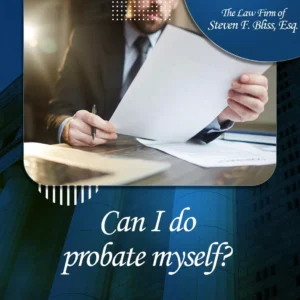What is the new online Probate Process?
Can I do Probate Myself?
Listen to this Article on:
Completing Probate on Your Own.

When considering the question, you need to weigh the amount of time and possibly specialized knowledge required against legal costs. What potential complications might arise? Probate involves several steps, and the first is filing a petition for Probate with the decedent’s county probate court. For the first time, filing a petition for Probate can be done entirely online.
Nonetheless, it will begin with a phone call, wherein a probate professional will gather all the required information to prepare your California
Petition to Probate form. The Probate professional will prepare and complete the forms for you. Then, you’ll be required to sign the form via eSignature.
What is required to file a petition to Probate?
Please Help Us Spread The Word By Giving Us a 5 Star Rating on This Article
Free Initial Consultation with
Steven F. Bliss Esq.

★ ★ ★ ★ ★

There are three essential documents required to file a petition to Probate:
Step 1: Filing the Petition at Probate Court.
Notwithstanding, the first step in initiating probate proceedings is filing a petition with the California Superior Court in the county where the deceased resided at the time of her death. This petition will trigger the court to schedule a hearing in approximately thirty (30) days.
Step 2: Handling of Notices in Compliance with Probate Proceedings.
After the petition is filed with the court, the notice of hearing will be published a minimum of three times in the local newspaper. Accordingly, it is also necessary to mail the notice to everyone named in the will (if there was one), along with all legal heirs of the deceased. The notice must also be provided to potential creditors.
Step 3: Proving the Will to the Probate Court.
If there is a will, it is necessary to “prove” the will unless it qualifies as a “self-proving” will.
In some cases, the will contains specific language and an affidavit from everyone signing the will, making it unnecessary to prove the will’s validity. Each state has its own rules regarding whether or not self-proving wills are valid and, if so, how they must be created.
Step 4: Asset Collection.
One of the primary duties of the personal representative is to take possession of all of the deceased’s assets, but only those that are subject to Probate. Some types of estate planning instruments are not required to go through Probate. If the title of an asset needs to be transferred into someone else’s name, the personal representative must take care of that. Some types of assets that may require a title change include:
• Stocks and Bonds
• Mutual Funds
• Brokerage Accounts
• Bank and Credit Union Accounts
• Physical assets such as real property, motor vehicles, boats, and planes
The court usually requires an inventory of the estate property. Sometimes an appraisal of a particular property may be required.
Step 5: Payments to Creditors.
Once the personal representative has provided notice of the death to creditors, those with debts payable by the estate must submit a claim. If those claims are valid, they will be paid from the estate.
All valid debts must be paid before other distributions can be made. This includes all bills, as well as funeral expenses. California requires creditors to submit their claims within four months of the appointment of the personal representative.
Step 6: Estate Tax Payments.
The personal representative is also responsible for making sure all estate taxes are paid, including federal estate taxes and state taxes, which the state of California imposes.
In most cases, a personal representative would not be held personally liable for estate taxes. Still, if the estate has been distributed before the taxes are paid, and there isn’t sufficient property left to pay those taxes, personal liability may be imposed.
Step 7: Conclusion of Probating the Estate.
The final step is closing the estate. This last step involves accounting for all actions taken by the personal representative concerning the estate. A petition, which summarizes the estate and reports all actions taken on behalf of the state, will be filed with the court. The petition also includes the fees to be paid to the personal representative and the estate attorney, if applicable. If there are no objections and the court approves the accounting, the court will enter an order concluding the estate. Once this happens, the personal representative can then distribute the remaining assets to heirs and pay any necessary fees.
You will get your inheritance faster if you begin and complete the probate process sooner. So, it’s to your advantage, and the other heirs, to get rolling. If you’re going to use a credible probate attorney, contact Steven F. Bliss Esq’s Law Firm and achieve your goals today.
